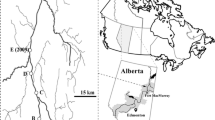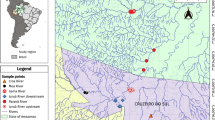Abstract
In this study, we examined the impacts of small weirs on the parasite community of gudgeon and toxostome in a medium-sized river. We tested changes on parasite species diversity using indices that capture both richness and abundance characteristics, and we examined parasite community structure with null models (co-occurrence index C score) and a multiple discriminant function analysis (MDFA). Our results showed that parasite community diversity of gudgeon is strongly influenced by weirs with a maximum diversity upstream of the weirs. Weirs also induce change in abundance of gudgeon parasite species particularly during summer. Nevertheless, we obtained that weirs had no effect on the parasite co-occurrence patterns. In addition, similarity indices indicate that the parasite faunas of newly established limnophilic species (roach and bleak) are host-specific and are rarely transmitted to other fish species. We conclude that fish parasite communities responded in different ways to the presence of impassable weirs, but, in a general tendency, changing environmental conditions induced by weirs may represent an ecological risk.



Similar content being viewed by others
References
Bakke TA, Jansen PA, Hansen LP (1990) Differences in the host resistance of Atlantic salmon, Salmo salar L., stocks to the monogenean Gyrodactylus salaris Malmber, 1957. J Fish Biol 37:577–587
Barger MA, Esch GW (2001) Downstream changes in the composition of the parasite community of fishes in an Appalachian stream. J Parasitol 87(2):250–255
Baumgartner LJ (2007) Diet and feeding habits of predatory fishes upstream and downstream of a low-level weir. J Fish Biol 70(3):879–894
Bush AO, Lafferty KD, Lotz JM, Shostak AW (1997) Parasitology meets ecology on its own terms: Margolis et al. revised. J Parasitol 83:547–583
Cattadori IM, Haydon DT, Hudson J (2005) Parasites and climate synchronize red grouse populations. Nature 433:737–741
Connor EF, Simberloff D (1979) The assembly of species communities: chance or competition. Ecology 60:1132–1140
Cornell HV (1993) Unsaturated patterns in species assemblages: the role of regional processes in setting local species richness. In: Ricklefs RE, Schluter D (eds) Species diversity in ecological communities. University of Chicago Press, Chicago, Illinois, USA, pp 243–252
Esch GW, Bush AO, Aho JM (1990) Parasite communities: patterns and processes. Chapman & Hall, London
Euzet L, Combes C (1980) Les problèmes de l’espèce chez les animaux parasites. Bull Soc de Zool Fr 40:239–285
Fahrig L (2003) Effects of habitat fragmentation on biodiversity. Annu Rev Ecol Evol Syst 34:487–515
Fellis KJ, Negovetich NJ, Esch GW, Horak IG, Boomker J (2003) Patterns of association, nestedness, and species co-occurrence of helminth parasites in the greater kudu, Tragelaphus strepsiceros, in the Kruger National Park, South Africa and the Etosha National Park, Namibia. J Parasitol 89:899–907
Fernando CH (1991) Impacts of fish introduction in Tropical Asia and America. Can J Fish Aquat Sci 48(Suppl 1):24–32
Fryer G (1982) The parasitic copepoda and branchiura of British freshwater fishes. A handbook and key. Freshwater Biological Association, The Ferry House, Ambleside, Cumbria, p 87
Georgiev B, Biserkov V, Genov T (1986) In toto staining method for cestodes with iron acetocarmine. Helminthologia 23:279–281
Gotelli NJ (2000) Null model analysis of species co-occurrence patterns. Ecology 81:2606–2621
Gotelli NJ, Graves GR (1996) Null models in ecology. Smithsonian Institution Press, VA
Gotelli NJ, Rohde K (2002) Co-occurrence of ectoparasites of marine fishes: a null model analysis. Ecol Lett 5:86–94
Gozlan RE, St-Hilaire S, Feist SW, Martin P, Kent ML (2005) Disease threats on European fish. Nature 435:1003–1136
Guégan JF, Hugueny B (1994) A nested parasite species subset pattern in tropical fish: host as major determinant of parasite infracommunity structure. Oecologia 100:184–189
Guilmet M (1997) Schéma départemental à vocation piscicole—Aveyron–Bassin du Viaur—Synthèse. pp 102. FDAAPPMA, Aveyron
Gussev AV (1985) Key to parasite of freshwater fish of the USSR. Metazoan parasites, vol 2 (in Russian). Academy of Sciences, Leningrad
Halmetoja A, Valtonen ET, Taskinen J (1992) Trichodinids (Protozoa) on fish from four Central Finnish lakes of differing water quality. Aqua Fenn 22:59–70
Holmes JC, Price PW (1986) Communities of parasites. In: Kikkawa J, Anderson DJ (eds) Community ecology: patterns and processes. Blackwell Scientific Publications, Oxford, pp 187–213
Ishtiaq F, Beadell JS, Baker AJ, Rahmani AR, Jhala YV, Fleischer RC (2006) Prevalence and evolutionary relationships of haematozoan parasites in native versus introduced populations of common myna Acridotheres tristis. Proc R Soc Lond B 273:587–594
Kadlec D, Šimková A, Jarkovský J, Gelnar M (2003) Parasite communities of freshwater fish under flood condition. Parasitol Res 89:272–283
Karvonen A, Cheng GH, Valtonen ET (2005) Within-lake dynamics in the similarity of parasite assemblages of perch (Perca fluviatilis). Parasitology 131:817–823
Khalil LF, Jones A, Bray RA (1994) Keys to the cestode parasites of vertebrates. International Institute of Parasitology an Institute of CAB International, hardback, 768 pp
Khan RA, Thulin J (1991) Influence of pollution on parasites of aquatic animals. Adv Parasitol 30:201–238
Koskivaara M (1992) Environmental factors affecting monogeneans parasitic on freshwater fishes. Parasitol Today 8:339–342
Koskivaara M, Valtonen ET, Prost M (1991) Dactylogyrids on the gills of roach in Central Finland: features of infection and species composition. Int J Parasitol 21:565–572
Lafferty KD, Kuris AM (1999) How environmental stress affects the impacts of parasites. Limnol Oceanogr 44:925–931
Landsberg JH, Blakesley BA, Reese RO, Mcrae G, Forstchen PR (1998) Parasites of fish as indicators of environmental stress. Environ Monit Assess 51(1–2):211–232
Legendre P, Legendre L (1998) Numerical ecology (2nd English edn). Elsevier, Amsterdam
Loot G, Aldana M, Navarrete S (2005) Marine protected areas and parasitism in intertidal food webs. Conserv Biol 19:203–212
Magurran AE (2004) Measuring biological diversity. Blackwell Publishing, Maldan, MA
McCallum H, Dobson A (2002) Disease, habitat fragmentation and conservation. Proc R Soc Lond B 269:2041–49
Meldgaard T, Nielsen EE, Loeschcke V (2003) Fragmentation by weirs in a riverine system: a study of genetic variation in time and space among populations of European grayling (Thymallus thymallus) in a Danish river system. Conserv Genet 4:735–747
Moravec F (1994) Parasitic nematodes of freshwater fishes of Europe. Academia, Prague, 473 pp
Morita K, Yamamoto S (2002) Effects of habitat fragmentation by damming on the persistence of stream-dwelling charr populations. Conserv Biol 16:1318–1323
Mouillot D, George-Nascimento M, Poulin R (2005) Richness, structure and functioning in metazoan parasite communities. Oikos 109:447–460
Nilsson C, Reidy CA, Dynesius M, Revenga C (2005) Fragmentation and flow regulation of the world’s large river systems. Science 308:405–408
Olstad K, Cable J, Robertsen G, Bakke TA (2006) Unpredicted transmission strategy of Gyrodactylus salaris (Monogenea: Gyrodactylidae): survival and infectivity of parasites on dead hosts. Parasitology 133:33–41
Ovidio M, Philippart JC (2002) The impact of small physical obstacles on upstream movements of six species of fish. Hydrobiologia 483:55–69
Poulin R (1992) Toxic pollution and parasitism in freshwater fish. Parasitol Today 8:58–61
Poulin R, Valtonen ET (2002) The predictability of helminth community structure in space: a comparison of fish populations from adjacent lakes. Int J Parasitol 32:1235–1243
Prenter J, MacNeil C, Dick JTA, Dunn AM (2004) Roles of parasites in animal invasions. Trends Ecol Evol 19(7):385–390
R Development Core Team (2005) R: a language and environment for statistical computing. R Foundation for Statistical Computing, Vienna, Austria. ISBN 3-900051-07-0, URL http://www.R-project.org
Rosenberg DM, Berkes F, Bodaly RA, Hecky RE, Kelly CA, Rudd JWM (1997) Large-scale impacts of hydroelectric development. Environ Rev 5:27–54
Salvati L, Bolognesi M, Ascenzi P (2002) Does inhibition of Trypanosoma cruzi key enzymes affect parasite life cycle and geographic distribution? IUBMB Life 53(1):45–47
Sanders NJ, Gotelli NJ, Heller NE, Gordon DM (2003) Community disassembly by an invasive species. Proc Natl Acad Sci USA 100(5):2474–2477
Sidall R, Koskivaara M, Valtonen ET (1997) Dactylogyrus (Monogenea) infections on the gills of roach (Rutilus rutilus L.) experimentally exposed to pulp and paper mill effluent. Parasitology 114:439–446
Šimková A, Gelnar M, Sasal P (2001) Aggregation of congeneric parasites (Monogenea: Dactylogyrus) among gill microhabitats within one host species (Rutilus rutilus). Parasitology 123:599–607
Šimková A, Verneau O, Gelnar M, Morand S (2006) Specificity and specialization of congeneric monogeneans parasitizing cyprinid fish. Evolution 60(5):1023–1037
Stone L, Roberts A (1990) The checkerboard score and species distributions. Oecologia 85:74–79
Stone L, Dayan T, Simberloff D (2000) On desert rodents, favored states, and unresolved issues: scaling up and down regional assemblages and local communities. Am Nat 156:322–328
Sures B (2003) Accumulation of heavy metals by intestinal helminths in fish: an overview and perspectives. Parasitology 126:S53–S60
Torchin ME, Lafferty KD, Kuris AM (1996) Infestation of an introduced host, the European green crab, Carcinus maenas, by a symbiotic nemertean egg predator, Carcinonemertes epialti. J Parasitol 82(3):449–453
Torchin ME, Lafferty KD, Kuris AM (2002) Parasites and marine invasions. Parasitology 124:S137–S151
Torchin ME, Lafferty KD, Dobson AP, McKenzie VJ, Kuris AM (2003) Introduced species and their missing parasites. Nature 421:628–630
Valtonen ET, Holmes JC, Aronen J, Rautalahti I (2003) Parasite communities as indicators of recovery from pollution: parasites of roach (Rutilus rutilus) and perch (Perca fluviatilis) in Central Finland. Parasitology 126:S43–S52
Walker KF, Thoms MC (1993) Environmental effects of flow regulation on the lower River Murray, Australia. Regulated Rivers Research & Management RRRMEP 8(1–2):103–119
Ward JV, Stanford JA (1983) The intermediate disturbance hypothesis: an explanation for biotic diversity patterns in the lotic ecosystems. In: Fontaine TD, Bartell SM (eds) The dynamics of lotic ecosystems. Ann Arbor Science, Michigan, pp 47–63
Wofford JEB, Gresswell RE, Banks MA (2005) Influence of barriers to movement on within-watershed genetic variation of coastal cutthroat trout. Ecol Appl 15:628–637
Acknowledgements
AŠ was founded by the Research Project of Masaryk University, Brno, Project N.: MSM 0021 622 416. This manuscript was much improved by the comments of Robert Poulin. We are grateful to David J. Paèz and Candida Shinn for correcting the English. We would like to thank Milan Gelnar, Boena Koubková and Markéta Ondraèková, (Department of Botany and Zoology, Faculty of Science, Masaryk University, Brno, Czech Republic) and Salah Bouamer (Centre de Biologie et Gestion des Populations, Campus international de Baillarguet, Montpellier, France) for their help with parasite determination. We are in debt to Fabien Leprieur who helped us in statistical analyses.
Author information
Authors and Affiliations
Corresponding author
Appendix
Appendix
Rights and permissions
About this article
Cite this article
Loot, G., Reyjol, Y., Poulet, N. et al. Effects of small weirs on fish parasite communities. Parasitol Res 101, 1265–1276 (2007). https://doi.org/10.1007/s00436-007-0632-6
Received:
Accepted:
Published:
Issue Date:
DOI: https://doi.org/10.1007/s00436-007-0632-6




